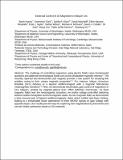| dc.contributor.author | Huang, Bevin | |
| dc.contributor.author | Clark, Genevieve | |
| dc.contributor.author | Navarro-Moratalla, Efrén | |
| dc.contributor.author | Seyler, Kyle L. | |
| dc.contributor.author | Wilson, Nathan | |
| dc.contributor.author | McGuire, Michael A. | |
| dc.contributor.author | Cobden, David H. | |
| dc.contributor.author | Xiao, Di | |
| dc.contributor.author | Yao, Wang | |
| dc.contributor.author | Xu, Xiaodong | |
| dc.contributor.author | Klein, Dahlia Rivka | |
| dc.contributor.author | MacNeill, David | |
| dc.contributor.author | Jarillo-Herrero, Pablo | |
| dc.date.accessioned | 2019-03-29T19:35:15Z | |
| dc.date.available | 2019-03-29T19:35:15Z | |
| dc.date.issued | 2018-04 | |
| dc.identifier.issn | 1748-3387 | |
| dc.identifier.issn | 1748-3395 | |
| dc.identifier.uri | http://hdl.handle.net/1721.1/121118 | |
| dc.description.abstract | Controlling magnetism via electric fields addresses fundamental questions of magnetic phenomena and phase transitions, and enables the development of electrically coupled spintronic devices, such as voltage-controlled magnetic memories with low operation energy. Previous studies on dilute magnetic semiconductors such as (Ga,Mn)As and (In,Mn)Sb have demonstrated large modulations of the Curie temperatures and coercive fields by altering the magnetic anisotropy and exchange interaction. Owing to their unique magnetic properties, the recently reported two-dimensional magnets provide a new system for studying these features. For instance, a bilayer of chromium triiodide (CrI[subscript 3]) behaves as a layered antiferromagnet with a magnetic field-driven metamagnetic transition15,16. Here, we demonstrate electrostatic gate control of magnetism in CrI[subscript 3] bilayers, probed by magneto-optical Kerr effect (MOKE) microscopy. At fixed magnetic fields near the metamagnetic transition, we realize voltage-controlled switching between antiferromagnetic and ferromagnetic states. At zero magnetic field, we demonstrate a time-reversal pair of layered antiferromagnetic states that exhibit spin-layer locking, leading to a linear dependence of their MOKE signals on gate voltage with opposite slopes. Our results allow for the exploration of new magnetoelectric phenomena and van der Waals spintronics based on 2D materials. | en_US |
| dc.publisher | Springer Nature | en_US |
| dc.relation.isversionof | http://dx.doi.org/10.1038/S41565-018-0121-3 | en_US |
| dc.rights | Article is made available in accordance with the publisher's policy and may be subject to US copyright law. Please refer to the publisher's site for terms of use. | en_US |
| dc.source | arXiv | en_US |
| dc.title | Electrical control of 2D magnetism in bilayer CrI[subscript 3] | en_US |
| dc.type | Article | en_US |
| dc.identifier.citation | Huang, Bevin, Genevieve Clark, Dahlia R. Klein, David MacNeill, Efrén Navarro-Moratalla, Kyle L. Seyler, Nathan Wilson, et al. “Electrical Control of 2D Magnetism in Bilayer CrI[subscript 3].” Nature Nanotechnology 13, no. 7 (April 23, 2018): 544–548. © 2018 The Authors | en_US |
| dc.contributor.department | Massachusetts Institute of Technology. Department of Physics | en_US |
| dc.contributor.mitauthor | Klein, Dahlia Rivka | |
| dc.contributor.mitauthor | MacNeill, David | |
| dc.contributor.mitauthor | Jarillo-Herrero, Pablo | |
| dc.relation.journal | Nature Nanotechnology | en_US |
| dc.eprint.version | Original manuscript | en_US |
| dc.type.uri | http://purl.org/eprint/type/JournalArticle | en_US |
| eprint.status | http://purl.org/eprint/status/NonPeerReviewed | en_US |
| dc.date.updated | 2019-03-27T13:36:17Z | |
| dspace.orderedauthors | Huang, Bevin; Clark, Genevieve; Klein, Dahlia R.; MacNeill, David; Navarro-Moratalla, Efrén; Seyler, Kyle L.; Wilson, Nathan; McGuire, Michael A.; Cobden, David H.; Xiao, Di; Yao, Wang; Jarillo-Herrero, Pablo; Xu, Xiaodong | en_US |
| dspace.embargo.terms | N | en_US |
| dc.identifier.orcid | https://orcid.org/0000-0001-9581-2105 | |
| dc.identifier.orcid | https://orcid.org/0000-0001-8217-8213 | |
| mit.license | PUBLISHER_POLICY | en_US |
